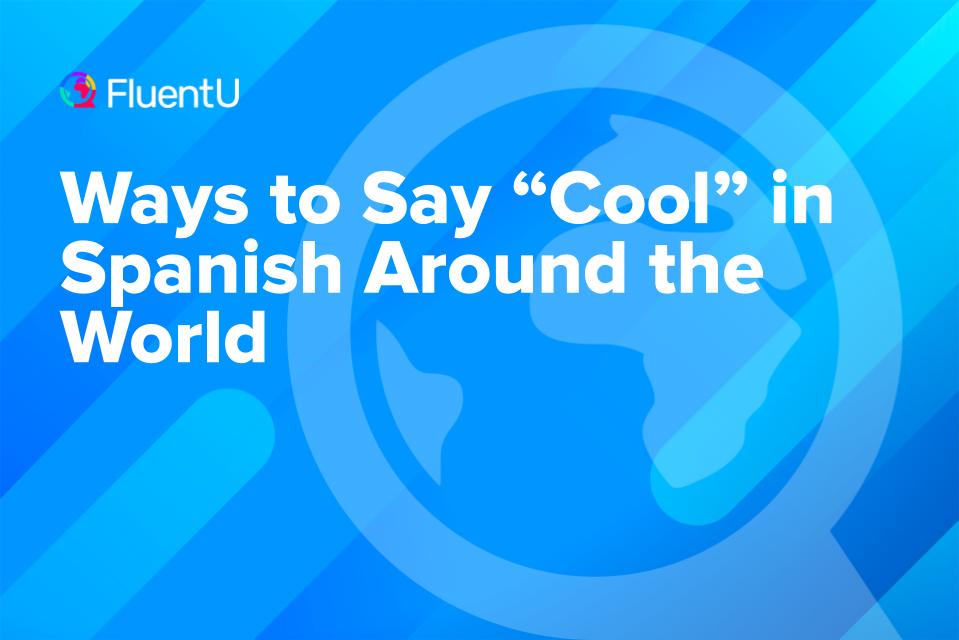Contents
- 1. Bacán / Bacano
- 2. Bárbaro
- 3. Buena onda
- 4. Buenazo
- 5. Cachete
- 6. Cachilupi
- 7. Calidá
- 8. Chévere
- 9. Chido
- 10. Choy
- 11. Copado
- 12. Descueve
- 13. Es una pasada
- 14. Genial
- 15. Guay
- 16. Gufeao / Gufiao
- 17. Molar
- 18. Molón / Molona
- 19. Nítido
- 20. Padre
- 21. Pichudo
- 22. Piola / Quedarse piola
- 23. Estar de poca madre / A toda madre
- 24. Pulento
- 25. Pura vida
- 26. Qué chilero
- 27. Suave
- 28. Topísimo
- 29. Tuanis
- 30. Zarpado
- And One More Thing…
Ways to Say “Cool” in Spanish Around the World

Your Spanish skills are already pretty great if you’ve mastered Mexican slang and tried learning and using colloquial words from Spain and other Spanish-speaking countries.
But now, it’s time to learn 30 Spanish words for “cool.” As we’ll see, there are plenty of ways to say “cool,” but some are decidedly less cool than others.
Download: This blog post is available as a convenient and portable PDF that you can take anywhere. Click here to get a copy. (Download)
1. Bacán / Bacano
In Chile, Colombia, Peru and Cuba, bacán is used to describe something as cool.
In Colombia in particular, it may sometimes appear as bacano.
Este hotel es bacán
/ bacano.
(This hotel is cool.)
Be careful with this one, though. In other parts of the Spanish-speaking world, this word can mean anything from “lover” to “boss” to “steep” to “posh” because we live in a strange and confusing world.
2. Bárbaro
This word literally means “barbarian” or “barbaric,” so you’d think it would be a negative. Indeed, it’s often used to describe something terrible. However, in Argentina, it’s frequently used to mean “cool.”
¿Te has comprado un convertible? ¡Qué bárbaro!
(You bought a convertible? How cool!)
3. Buena onda
Onda literally means “wave” or “ripple,” so buena onda is “good wave.” Buena onda is used in Argentina, Chile and Mexico to mean “cool” or “good vibe.”
Ella es buena onda porque siempre va a todas las fiestas.
(She is cool because she always goes to all the parties.)
4. Buenazo
Used in Ecuador, Costa Rica and Peru, buenazo is the equivalent of “cool” or “really good.” It’s generally used to describe inanimate objects rather than people.
Ese coche es buenazo.
(That car is cool.)
It can be also used to speak about people, but in that case it can mean anything from “really good looking” to “kindhearted person who is a bit too soft,” so before using it, check its meaning in the country where you are.
5. Cachete
While cachete literally means “cheek,” it’s used in Chile and Costa Rica to mean “cool.” It’s often used with a todo .
¿Vas a Chile? ¡A todo cachete!
(You’re going to Chile? How cool!)
6. Cachilupi
This word is used in Chile to mean “cool” or “nice.”
Este lugar es muy cachilupi.
(This place is really cool.)
7. Calidá
Calidá is Guatemalan slang for “cool” or “excellent.”
Esta playa es calidá.
(This beach is cool.)
8. Chévere
For Spanish students, this is probably one of the more familiar words for “cool.” It’s used throughout Latin America.
Qué chévere, no tenemos tarea.
(How cool/awesome, we don’t have homework.)
9. Chido
Chido is a Mexican slang term for “cool.”
Las vacaciones estuvieron muy chidas.
(Vacation was really cool.)
10. Choy
Choy is used as “cool” in Peru.
¿Has visto Machu Picchu? ¡Es choy!
(Have you seen Machu Picchu? It’s cool!)
11. Copado
While it literally means “tufted,” copado is used to mean “cool” in Argentina and Uruguay.
La clase es muy copada.
(The class is very cool.)
12. Descueve
Descueve is used to mean “cool” or “fantastic” in Chile.
El Valle de la Luna es el descueve.
(The Valley of the Moon is very cool.)
13. Es una pasada
In Spain, es una pasada is used colloquially as “cool” or “nice.” Hint: it stays feminine even if you’re using it to describe masculine nouns.
Este artículo es una pasada.
(This article is cool).
14. Genial
This term is used widely throughout Spanish-speaking countries (though somewhat less often in Colombia and Ecuador). It literally means “great,” but it’s often used to mean “cool.”
Ella es genial.
(She is cool.)
15. Guay
Guay is another common slang term that many Spanish students learn in school. It’s popular among children and teenagers in Spain.
¡Qué guay!
(How cool!)
16. Gufeao / Gufiao
This Puerto Rican term can be spelled either way. It can be used to describe people or objects.
Tu teléfono nuevo está gufeao
/ gufiao.
(Your new phone is cool.)
17. Molar
While the noun molar means “molar,” as in the tooth, the verb molar means “to be cool” in Spain.
La camiseta mola.
(The t-shirt is cool.)
18. Molón / Molona
This word is mostly used in Spain. It means “cool” or “neat.”
Esta película es molona.
(This movie is cool.)
19. Nítido
While nítido literally means “vivid” or “clear,” it’s used to mean “cool” in Puerto Rico.
¿Arepas para el desayuno? ¡Qué nítido!
(Arepas for breakfast? Cool!)
20. Padre
As you’ve probably already realized, this word literally means “father.” In Mexico, however, it’s also used to mean “cool.”
Me encanta tu casa. ¡Está muy padre!
(I love your house. It’s very cool!)
21. Pichudo
Pichudo is commonly used by Costa Rican teenagers to mean “cool.”
Tus gafas son pichudas.
(Your glasses are cool.)
22. Piola / Quedarse piola
Piola literally means “rope” or “string.” In Argentina and Chile, though, piola means “cool” as in “calm.” Quedarse piola is “to stay cool.”
Ese invento está piola.
(That invention is cool)
Él solo quiere provocarte. Quédate piola.
(He just wants to provoke you. Stay cool.)
23. Estar de poca madre / A toda madre
While poca madre literally means “little mother” or “motherless,” in Mexico, estar de poca madre can mean “to be cool.” Poca madre can also be used to criticize someone, so be careful—don’t direct it at a person.
A toda madre is a slang expression often used in informal contexts in Mexico to say that something is “cool” or “awesome.”
¡Tu moto está de poca madre!
(Your motorcycle is cool!)
¡La cena estuvo a toda madre!
(Dinner was awesome!)
24. Pulento
Mostly used by poor residents of downtown Santiago, Chile, pulento means “cool.”
Tus pantalones nuevos están pulentos.
(Your new pants are cool.)
25. Pura vida
While it literally translates to “pure life,” this popular Costa Rican phrase more often means something similar to “cool.”
No hay problema. Todo pura vida.
(There is no problem. Everything is cool.)
26. Qué chilero
This Guatemalan slang for “how cool” is so popular that a children’s show is named after it.
¿No hay huracán? ¡Qué chilero!
(There isn’t a hurricane? How cool!)
27. Suave
Suave literally means “smooth,” but it can be used in some Spanish-speaking countries to mean something similar to “cool.”
George Clooney es muy suave.
(George Clooney is very cool.)
28. Topísimo
In Chile, topísimo means “cool” or “hip.”
El concierto fue topísimo.
(The concert was cool.)
29. Tuanis
Tuanis is a term used in Costa Rica, Honduras, Nicaragua and El Salvador. It’s very similar to pura vida.
Tu reloj es bien tuanis.
(Your watch is cool.)
30. Zarpado
In Argentina, zarpado is often used to mean “cool.” That being said, zarpado can also refer to someone who has stepped out of line, so use it with caution.
¿Fuiste a la fiesta? ¡Qué zarpado!
(You went to the party? How cool!)
If you’re craving even more Spanish slang, check out this blog post, which wraps up with a list of all our Spanish slang posts:
Common Spanish Slang from Around the World (Audio Included) | FluentU Spanish Blog
Spanish slang is your key to sounding like a native. And with 291 Spanish slang words and phrases, you’ll be able to fit in with any Spanish speaker! This post shows you…
As with any colloquial terms, these words are often nuanced, so it’s important to understand their use in real life—make sure you practice them in context so you don’t inadvertently overdo them!
Watching, listening to or reading authentic Spanish media is great for this, helping you keep your cool as native speakers do. The authentic content on FluentU in particular is aimed at language learners.
FluentU takes authentic videos—like music videos, movie trailers, news and inspiring talks—and turns them into personalized language learning lessons.
You can try FluentU for free for 2 weeks. Check out the website or download the iOS app or Android app.
P.S. Click here to take advantage of our current sale! (Expires at the end of this month)

By consuming native media, you’ll be able to not only learn cool colloquial words but also identify when and how to use them.
Now you know 30 ways to say “cool” in Spanish, it’s time to start using them in your own conversations!
¡Qué padre! (How cool!)
Download: This blog post is available as a convenient and portable PDF that you can take anywhere. Click here to get a copy. (Download)
And One More Thing…
If you've made it this far that means you probably enjoy learning Spanish with engaging material and will then love FluentU.
Other sites use scripted content. FluentU uses a natural approach that helps you ease into the Spanish language and culture over time. You’ll learn Spanish as it’s actually spoken by real people.
FluentU has a wide variety of videos, as you can see here:

FluentU brings native videos within reach with interactive transcripts. You can tap on any word to look it up instantly. Every definition has examples that have been written to help you understand how the word is used. If you see an interesting word you don’t know, you can add it to a vocab list.

Review a complete interactive transcript under the Dialogue tab, and find words and phrases listed under Vocab.

Learn all the vocabulary in any video with FluentU’s robust learning engine. Swipe left or right to see more examples of the word you’re on.

The best part is that FluentU keeps track of the vocabulary that you’re learning, and gives you extra practice with difficult words. It'll even remind you when it’s time to review what you’ve learned. Every learner has a truly personalized experience, even if they’re learning with the same video.
Start using the FluentU website on your computer or tablet or, better yet, download the FluentU app from the iTunes or Google Play store. Click here to take advantage of our current sale! (Expires at the end of this month.)








